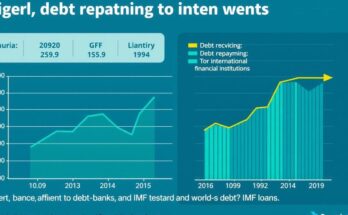European and Asian stock markets rose as investors welcomed China’s consumer plan aimed at boosting economic recovery amidst U.S. tariff concerns. While optimism persists, caution remains due to deflationary pressures. Upcoming monetary policy decisions from central banks are anticipated to influence market sentiment further.
On Monday, both European and Asian stock markets opened positively, buoyed by China’s initiative to revitalize consumption in its economy amid concerns over U.S. tariffs. This upward movement followed a rally on Wall Street, driven by increasing optimism that U.S. lawmakers would pass a budget to prevent a government shutdown.
Susannah Streeter, head of money and markets at Hargreaves Lansdown, remarked, “Hopes that a new consumer life raft in China will buoy up the country’s prospects of recovery have helped lift sentiment slightly, but caution remains.” Investors are particularly focused on the plans announced by Beijing aimed at stimulating consumer spending, addressing the economic slowdown experienced post-COVID.
The proposed measures include reforms in the property sector to raise income, stabilization of the stock market, and facilitation of consumer loans with favorable terms. Further initiatives include increasing pension benefits, creating a childcare subsidy system, and enforcing workers’ rights regarding rest and holidays.
Despite these efforts, concerns linger due to recent data indicating consumer prices have fallen into deflation for the first time in a year, with persistent reductions in producer prices. Economists from Moody’s Analytics commented, “With China firmly in U.S. President Donald Trump’s sights, deflation concerns in China will worsen.”
European stock indices reflected a positive trend, with markets in London, Paris, and Frankfurt making gains. Additionally, Asian markets such as Hong Kong and Tokyo experienced increased trading activity in leading tech firms. Traders are also preparing for upcoming monetary policy decisions from the Federal Reserve, Bank of Japan, and Bank of England, all anticipated to maintain current interest rates.
Gold prices were notably stable around $3,000 per ounce, following an earlier surge influenced by market anxieties linked to tariffs. As investors sought safe havens, the gold market reflected their concerns about the economic implications of the ongoing trade issues.
Key figures observed around 1100 GMT revealed an upward trend across major stock markets and currencies, signaling optimism despite ongoing challenges in the international trade landscape.
In summary, the recent increases in European and Asian stock markets are largely attributed to China’s newly unveiled consumer initiatives aimed at stimulating economic recovery. While there is cautious optimism regarding these measures, underlying challenges such as deflation and U.S. tariff policies continue to loom. Observers remain vigilant as traders await crucial monetary policy decisions from leading global central banks.
Original Source: www.news-graphic.com




